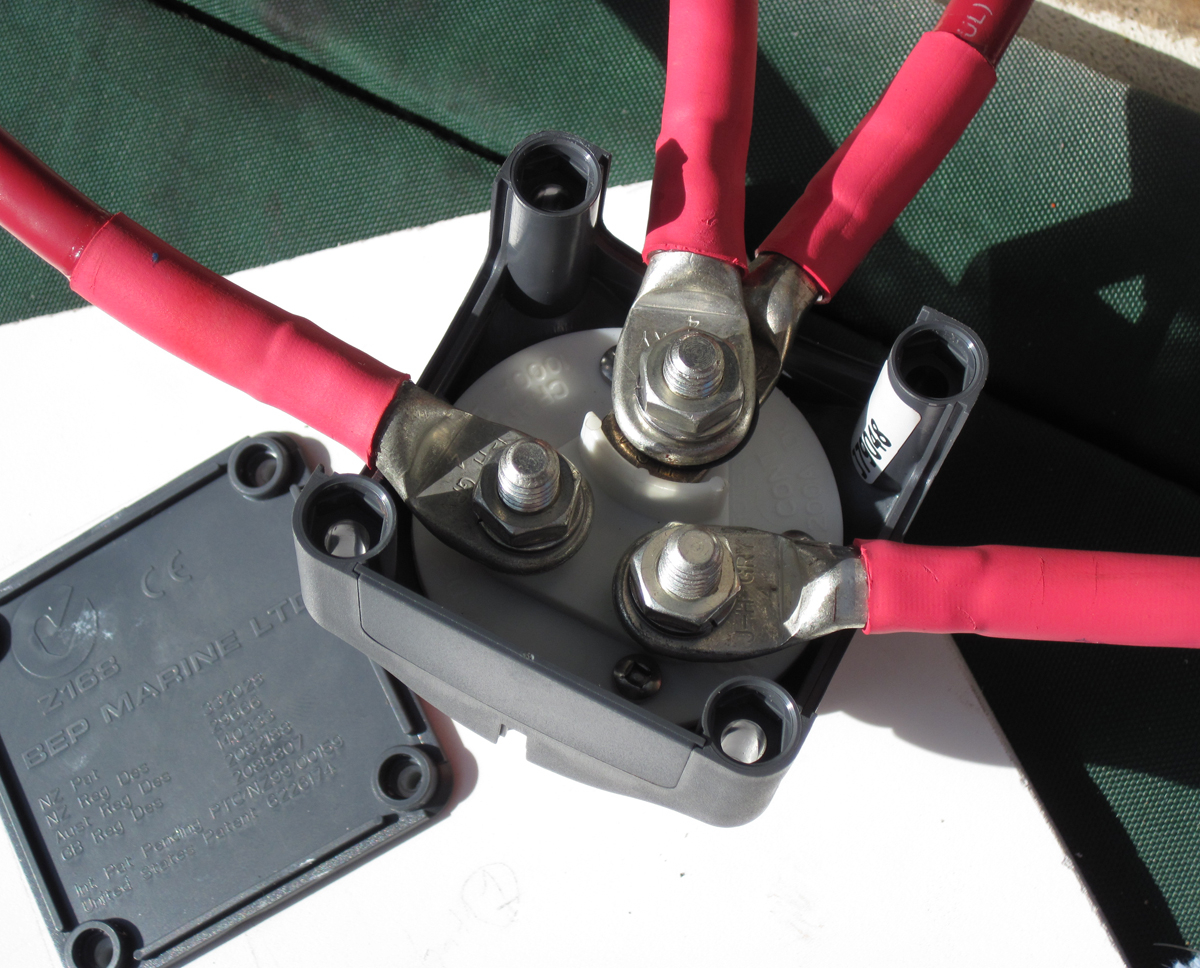March 10, 2015
By Al Herum
Keep your electronics going strong.
 New terminals for battery switch connection, always a good upgrade.
New terminals for battery switch connection, always a good upgrade.
Modern marine electronics (engines, too!) are sensitive to a voltage drop and frequently go offline or sound an alarm with even a small reduction in input voltage. Either way, you'll lose the use of the gear until you restore proper power.
Let's start with some electrical power basics. Your boat battery system needs to be in good working order and fully charged. If your boat uses multiple batteries you will need to make sure each individual unit is working and charged. In a no-load condition a fully charged battery should show 12.7 volts when checked with a meter.
You can do a down and dirty load check of a battery with a short run of the engine starter or a windlass or some other high draw item. A battery in good shape should hold at least 11 volts under a load; if it drops below 10 volts you may have a problem.
Marine batteries have threaded terminals to attach cables, and you should use marine-grade, stainless steel locknuts for secure connections (a loose wingnut can wreak havoc on your systems).
Making a new or replacing an old battery cable is not unlike making any other wire connection, with a few caveats. First off, you will be working with much heavier wire, bigger ring terminals, and shrink wrap as thick as the skin on an ocean triggerfish. Because everything is so oversized you'll need to do your cable construction work on the bench rather than on the boat. This means you will need accurate measurements of the cable length before you start building the finished battery cable. Use a piece of smaller wire, properly routed, and cut to length on the boat to get an accurate dimension.
[gallery link="file" columns="2"]
Build a battery cable using multistrand tinned copper wire rated for the marine environment. Top grade cable will be rated “600V 105°C Dry and 75°C Wet Oil Resistant.” Steer clear of wire that doesn't meet these standards. Cable ends should be marine-grade ring-type properly selected to fit the cable and attach point stud. Because it takes some serious force to properly crimp these large terminal ends you should use a bench-mounted crimping tool; the chandlery where you purchase the wiring supplies should have one for your use. Alternately, you may be able to borrow or rent a professional- grade swager for those 4 to 2/0 gauge ring terminals (these tools sell for upward of $400, making them somewhat unrealistic for the average boat-owner to have around). Finish off the connection with enough shrink wrap to seal the joint completely. When done properly there should be no way for water to reach the wire strands.
Another big part of your boat's power supply is the engine-driven alternator. This device provides additional electrical power, when the engine is running, to pick up the majority of the continuous electrical load and provide a charge to the batteries.
My son's vintage 20-foot SeaCraft offers an example of the worst-case scenario for an alternator. This boat has a single outboard with a 40-amp alternator to supply power for a radio, livewell pump, bilge pump, navigation lights, chartplotter/fishfinder, multi-purpose engine gauge, fuel gauge and stereo. The last item, the stereo, has multiple components including an amplifier that can draw as much as 40 amps by itself. Granted not everything is on at the same time very often; the fact is, the engine is a newer 4-stroke with an alternator capable of putting out a high percentage of its maximum output, even at idle, which keeps everything working well together. With an older engine and less efficient alternator, things might not work so well.
Make sure you analyze your power system in total before you make any big electrical additions to your boat. FS
Protect and Preserve
Exposed battery cable connections either at the battery itself or at a bus bar or terminal block must be protected against both corrosion and inadvertent contact. To protect against corrosion from salt air and seawater apply a liberal application of a corrosion inhibitor like Boeshield T-9, Corrosion X HD or Vaseline. Doing so will add significantly to component service life. Because of the enormous energy stored in a battery you need to protect, with a cover, battery terminals from accidental contact. Choose individual plastic covers for each terminal, or place the battery inside a covered battery box.
Right Sizing Cables
Choosing the right size battery cable to run from the positive battery terminal post to the battery switch, and from the negative battery terminal post to the main bus bar or feed terminal, requires calculating your maximum current draw and then referring to the appropriate chart.
If your batteries are located in the engine room of an inboard boat you should use the “Inside Engine Room” column, if not use the “Outside Engine Room” column. Your battery switch and main negative terminal should both be located as close to the battery bank as possible. Calculating your maximum amp draw should include all DC powered equipment on your boat including the engine starter. A large outboard starter can draw as much as 200 amps while cranking.
When in doubt, consult a local outboard dealer; he should be able to find a copy of the manufacturer's
recommendations for battery cable extensions. These of course differ from make to make, and model to model.

